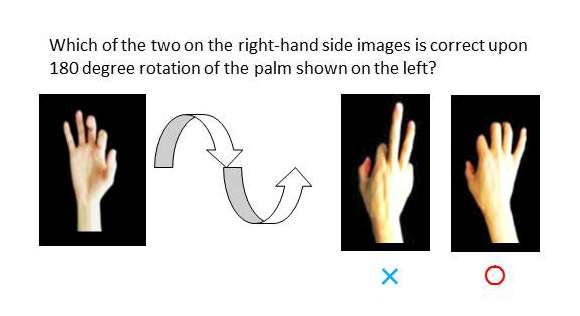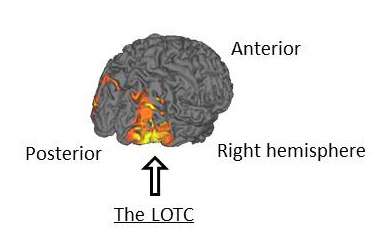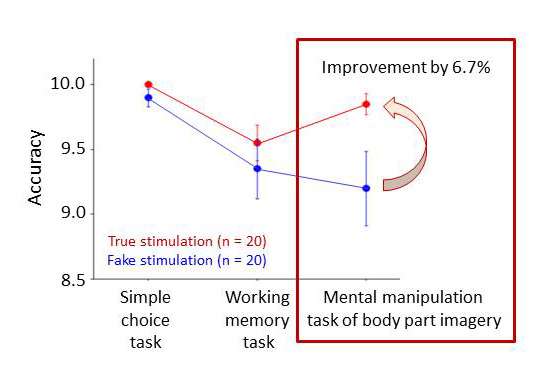After seeing an image of the palm, subjects are asked to select the correct image of the hand upon 180 degree rotation. The right-hand side image is correct in this task. Credit: Kanazawa University
Transcranial direct current stimulation (tDCS) is a method by which a very weak direct current is applied to the head of a subject for 10 to 20 minutes to induce changes in the activities of cranial nerves. It has recently been tested to investigate effects on rehabilitation of people with cerebral apoplexy and for possible depression therapy. Researchers are now investigating whether this method is effective for activating mental imagery of body part manipulation to accelerate exercise learning in rehabilitation.
However, activation sites in the brain are not well understood for this purpose. In this study, researchers conducted two experiments—the first experiment (E1) revealed which parts of the brain play roles in mental rotation of the hand. On the basis of the results of E1, the second experiment (E2) was performed to learn whether mental manipulation of body part imagery could be improved via transcranial direct current stimulation applied to the site that E1 determined.
The subjects were elderly persons exhibiting a range of symptoms of cognitive decline. The level of glucose metabolism in the brain was measured by means of positron emission tomography (PET), and the relationship of the glucose metabolism level was investigated with regard to the performance of mental rotation of the hand (Figure 1). The experiment demonstrated that reduction of the glucose metabolism in the lateral occipito-temporal cortex, LOTC, resulted in decreased performance in the task involving mental manipulation (Figure 2). That is, the LOTC was shown to be involved in the mental manipulation of body part imagery.
The region with yellow shade. Reduction of the function of this region induces declination of mental manipulation of body part imagery. Credit: Kanazawa University
Based on the E1 results, the researchers hypothesized that tDCS on the LOTC would improve the mental manipulation of body part imagery. In the second experiment, E2, the researchers evaluated mental manipulation of body part imagery, simple choice operations, and working memory. During the tasks, tDCS on the LOTC was applied; the same operation without direct current stimulation was performed as a control. The results indicated that the persons who underwent tDCS showed better mental manipulation performance by 6.7% over control subjects.
In mental manipulation task of body part imagery, tDCS brought about accuracy improvement by 6.7%, in comparison with the fake stimulation. Credit: Kanazawa University
It is anticipated that application of tDCS on the motor area of the cerebral cortex could improve the effects of rehabilitation of those with apoplexy. The current study has demonstrated for the first time the improvement of mental manipulation of body part imagery, an important ability in exercise learning, by stimulating the LOTC, which is involved in information processing of visual space of the body. The E2 results were obtained with healthy adults, and improvement was only a small percentage over the control group. Nevertheless, application of the current study may lead to amelioration of cognitive ability through improvement of mental manipulation of body part imagery, and eventually to quicker recovery of people in rehabilitation.
More information: Mitsuru Kikuchi et al, The Lateral Occipito-temporal Cortex Is Involved in the Mental Manipulation of Body Part Imagery, Frontiers in Human Neuroscience (2017). DOI: 10.3389/fnhum.2017.00181
Journal information: Frontiers in Human Neuroscience
Provided by Kanazawa University


























